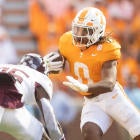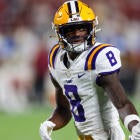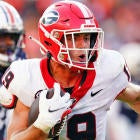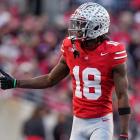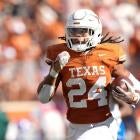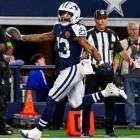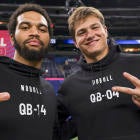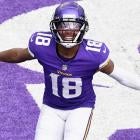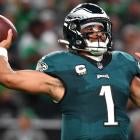Week 13 is always a pivotal one in Fantasy Football, as it can make or break a long season for teams on the playoff bubble. This year, it brought us Michael Thomas' worst statistical game of the season, Christian McCaffrey's second worst, Jared Goff and the Rams rebounding, a Derrius Guice breakout and results like Dolphins over Eagles and Texans over Patriots to remind us that even as the season winds down, the things we think we know about the NFL are always changing.
Let's go around the league and sort it all out before the Fantasy playoffs.
Data is typically courtesy of Pro Football Reference, RotoViz, the RotoGrinders Premium Usage App, airyards.com or PFF. Always feel free to hit me up on Twitter @YardsPerGretch with any questions about anything I covered or to ask my thoughts on something I glossed over. That is some of my favorite feedback, because sometimes it's something I've missed.
Here are some important statistical acronyms to know for Stealing Signals:
Green Zone - Inside the opponent's 10-yard line.
HVT - High-Value Touches: for running backs, all receptions and all touches inside the 10 yard line.
TRAP - Trivial Rush Attempt Percentage: for running backs, the percentage of all touches that are not high-value touches.
WOPR - Weighted Opportunity Rating: a metric created by Josh Hermsmeyer, it balances team share of targets and team share of air yards. Because a player's WOPR is a share of his team's overall opportunity, it's important to consider team volume as additional context.
RACR - Receiver Air Conversion Ratio: also created by Hermsmeyer, RACR is calculated as total receiving yards divided by total air yards. Similar to yards per reception or yards per target, but per air yard instead.
Week 13
Bears 24 - Lions 20
Snap Notes: Javon Wims: 89% (most since Week 5), Anthony Miller: 86% (matched season high), David Montgomery: 62% (fifth game over 60% in last six), Tarik Cohen: 55% (fourth straight game over 50%), Jesper Horsted: 11% (+6 vs. Week 12), Bo Scarbrough: 47% (-3 vs. Weeks 11 and 12), Ty Johnson: 33% (-3 vs. Week 12), J.D. McKissic: 22% (+7 vs. Week 12)
Key Stat: Bo Scarbrough — 1 high-value touch (Ty Johnson — 4, J.D. McKissic — 4)
- After under throwing his first pass by about 10 yards, David Blough immediately settled in and started slinging it, hitting a wide open Kenny Golladay for a 75-yard touchdown on his second throw, then hitting Marvin Jones for 19 and Golladay for 29 on the second drive before an 8-yard strike to Jones for another score. Blough went on to throw for 280 yards and two scores, parlaying that early downfield passing into a nice overall day. The lesson here is about vertical passing games. Before his injury, Matthew Stafford averaged the second most air yards per game this season. We can't be sure a team will scheme the same way with a backup, but we saw Jeff Driskel air it out plenty, and Blough's solid Fantasy day reiterated there's going to be more upside for a first-time starter in an aggressive offense.
- Unfortunately, with the Lions ahead, Blough wound up with a pretty conservative target distribution overall, hitting T.J. Hockenson for six of 11 targets at a 6.2 aDOT and Danny Amendola for three of eight at an aDOT of just 8.2. He also threw to the pass-catching backs, Ty Johnson and J.D. McKissic, a combined six times, and each had a negative aDOT on three looks. Blough threw for just 82 yards combined on those 25 attempts to underneath targets, though a few of them wound up moving the chains in key spots.
- As a result, Golladay and Jones wound up with fewer targets overall as the downfield weapons. Golladay had caught all four of his targets for 158 yards and the score until a desperation heave his direction on a 4th and 22 on the game's penultimate play was intercepted for Blough's lone turnover. Jones hauled in just one more pass after his touchdown, finishing 6-3-40-1.
- With the Lions out in front, early-down bruiser Bo Scarbrough rushed 21 times, racking up 83 yards. His long on the day was 15 yards, but he had a 21-yarder that would have put him over the century mark called back by a block in the back on Golladay in the fourth quarter. Though the Lions ran eight plays in the green zone, Scarbrough got just one touch in close, an early rush attempt from the 10. Detroit preferred spread looks with their passing downs backs in that area, frequently taking Scarbrough off the field. Johnson and McKissic, who finished with just three and two rushes overall, each had a green zone rush, including McKissic failing to convert a third and 1 from the 5 in the fourth quarter. Johnson also caught a pass in the green zone as the Lions threw several times in close. That usage was disappointing for Scarbrough's Fantasy potential, as his complete lack of a receiving role means those green zone touches are his only path to high-value touches.
- With Taylor Gabriel out, Mitchell Trubisky relied on Allen Robinson and Anthony Miller, who combined for a whopping 25 targets on his 38 attempts. Miller came up with three big catches for 78 yards on the Bears' go-ahead touchdown drive late, finishing the day with a huge 13-9-140 line. Robinson was predictably the top target early, catching three passes including a score on the team's first drive, and finished 12-8-86-1. Javon Wims got extended run in Gabriel's place, as he did back in Weeks 4 and 5, and was also involved with a 6-5-56 line.
- The Bears continued their recent trend of utilizing two-back sets, getting both David Montgomery and Tarik Cohen on the field at the same time. That's been a positive for Montgomery's routes run, and he caught the late go-ahead touchdown on such a play. Montgomery caught both of the targets he saw and added 75 rushing yards on 16 carries, while Cohen caught all four passes he saw and rushed three times but totaled just 35 yards.
- With the Bears thin at tight end, rookie UDFA Jesper Horsted caught an 18-yard touchdown on his lone target. But Horsted played just seven snaps overall and isn't a Fantasy option going forward.
Signal: Bo Scarbrough — taken off the field frequently in the green zone; Anthony Miller — big role with Gabriel out
Noise: Lions target distribution — Blough took some early shots downfield, mostly threw underneath
Bills 26 - Cowboys 15
Snap Notes: Devin Singletary: 78% (+5 vs. previous season high), Cole Beasley: 88% (third straight over 80%, had one such game prior), Cowboys: all five main 11 personnel guys over 70%
Key Stat: Devin Singletary — season-high 78% snap share
- The Bills came into Jerry World in what was probably the biggest test for their defense this season, given it was a short-week road game, and they won pretty handily. I wondered whether we'd see Frank Gore phased out a little bit more after he passed Barry Sanders on the all-time rushing list last week, and whether it was related to that or not, we did see Devin Singletary set a season high in snap share at 78%. His usage continues to rise, and while Josh Allen's scrambling can still be a limiting factor for Singletary's targets and his green zone touches, it's hard to argue with a 78% snap share. Singletary scored for the first time since Week 9 on a trick pass play thrown by John Brown, but he also later got a target on a third down from the 8-yard line. He now has at least 16 touches in three straight and four of his last five, and his four targets and three receptions were the fifth time he's hit both of those benchmarks.
- Allen rushed for another touchdown, his eighth on the season, which ties his 2018 total for the fifth most rushing touchdowns by a quarterback since 2000. The sample's plenty big enough now to recognize he should be expected to generate plenty of rushing scores, but it's also likely he'll be due for some regression. He has two more rushing scores than Lamar Jackson this season on fewer than half the rushing yards.
- With the Bills in front, Allen threw just 24 times, but he was efficient, leaning heavily on Cole Beasley underneath. Beasley caught six of seven passes at a 9.3 aDOT in his return to Dallas, generating 49 yards after the catch to put up his first 100-yard game of the season and score for the fifth time in his last seven games. John Brown saw just four targets at his typically high aDOT (19.0, 76 total air yards), but his three catches went for just 26 yards. He did have the passing touchdown. No one else in the Buffalo passing game has shown any reliability.
- Dak Prescott got off to a hot start, then turned the ball over twice in the second quarter as the Bills built their lead. Add in a couple missed field goals on subsequent drives, and the Cowboys could not generate points despite moving the ball fairly well en route to 426 total yards. Yes, some of that was late-game passing production in a multiple-score game, but we continue to see plenty of upside from this downfield passing attack, and it bounced back nicely from the weather-impacted game in Foxboro last week.
- There isn't much new in the Cowboys' usage splits. Their main 11 personnel grouping plays big snaps, and we've seen spike games from the secondary options like Randall Cobb and Jason Witten that make that production far from surprising. Deeper options like Tavon Austin (five targets) or Ventell Bryant (receiving touchdown) don't play enough snaps to be Fantasy options. Ezekiel Elliott rushed just 12 times in part due to script, but was targeted 10 times in the passing game, catching seven. Amari Cooper got back on track with 11 targets, catching eight for 85. Michael Gallup saw six targets, a bit underwhelming given Dak threw 49 times, but nothing too out of the ordinary.
Signal: Devin Singletary — role just keeps expanding; Cole Beasley — consistent enough usage to be in flex consideration as the second main passing option
Noise: Cole Beasley — 49 yards after the catch; Ventell Bryant — touchdown (played one snap)
Saints 26 - Falcons 18
Snap Notes: Alvin Kamara: 82% (most since Week 3), Christian Blake: 89% (+45 vs. Week 12 season high), Russell Gage: 68% (-5 vs. Week 12), Devonta Freeman: 67% (return from injury), Jaeden Graham: 59% (-7 vs. Week 12)
Key Stat: Taysom Hill — four offensive touches, 45 yards, two touchdowns
- The Saints coasted to the win, running just 49 offensive plays as their defense generated nine sacks and mostly played well against Atlanta. In part because the Falcons managed to recover two onside kicks, Atlanta ran 85 plays — 36 more than New Orleans.
- That helps explain Michael Thomas' 8-6-48 line, plus Alvin Kamara only totaling 15 touches. Taysom Hill's performance was also to blame for the lack of production elsewhere, as he caught an early touchdown and later added a 30-yard rushing score for the Saints' only two touchdowns on the day. The long run was good for the Saints but bad for Fantasy managers in that it took production off the table for the other guys while simultaneously helping New Orleans build a big lead.
- Kamara's snap share was actually his second-highest this season, and Latavius Murray played only sparingly, totaling just four carries and two rushing yards. The concern over Kamara continues, but he got the only running back green zone touch and clearly played ahead of Murray; his lack of touchdowns is the result of several odd team outcomes in recent weeks, and his overall usage remains very strong. I fully expect touchdown regression in the very near term.
- Jared Cook continued to look like the clear third option in the offense, catching three of six targets for 85 yards, but he did have an egregious drop in the end zone on what should have been an easy touchdown.
- With Julio Jones out, Christian Blake played a full snap share in his spot while Russell Gage continued to man the slot in the Mohamed Sanu role. Blake wound up with far more snaps, but it's role-specific, and if and when Jones is back we'll see Gage's snaps stay pretty stagnant while Blake will mostly return to the bench.
- Matt Ryan threw 50 times, 17 of which came on the final three drives generated by the two converted onside kicks. Calvin Ridley finished with a 10-8-91 line, while each of Gage and Blake saw nine targets, with Gage catching a late touchdown. Tight end Jaeden Graham caught all four balls thrown his way, including an earlier score.
- The backs also combined for 11 targets, but Devonta Freeman saw just five of those, as Brian Hill saw three, Kenjon Barner two and fullback Keith Smith one. Freeman played a healthy snap share in his return from injury, but that passing-game rotation limits what has already been a pretty limited profile for the lead Falcons back in an offense that entered Week 13 leading the NFL in pass attempts and doesn't generate much running back production overall.
Signal: Devonta Freeman — returned to a solid snap share, gave up more receiving work than we'd like to see
Noise: Alvin Kamara — lack of touchdowns; Taysom Hill — only two Saints touchdowns (four total touches); Saints — 49 offensive plays (and the associated limited touch counts for Kamara, Thomas)
Buccaneers 28 - Jaguars 11
Snap Notes: Peyton Barber: 39% (highest since Week 2), Ronald Jones: 28% (lowest since Week 8)
Key Stat: Ronald Jones — 6 touches in heavy positive script (i.e. favorable to RB)
- For as much as I'm a fan of Ronald Jones, I've warned several times about his usage and the Bucs' coaching staff's refusal to fully commit to him. Fantasy Football players saw the worst of that in a pivotal Week 13, as Peyton Barber scored an early 15-yard touchdown on a well-blocked run that frankly nearly any NFL back could have converted, then went on to dominate the backfield the rest of the day despite little production, turning his other 16 carries into 29 yards. Jones wasn't any better, but also got just six carries all day. Barber converted from 1 yard out for his second score, and also got a rush attempt on a 2-point conversion. We've discussed Jones' lack of usage at the goal line, and Barber was productive in close and has been fine as a short-yardage back, but that's not work Jones has proven incapable of handling — in fact, it's been the opposite, as Jones has converted touchdowns on all three of the green zone touches he's seen since the Week 7 bye. The simple truth is the Bucs have shown us time and again they prefer the inferior back, and there's little to explain it, from traditional production metrics to PFF grades. The possible exception being pass-blocking grade where Jones has been poor but both Barber and passing downs back Dare Ogunbowale have also graded as subpar. At any rate, we know we can't trust Jones' workload, though we can't really trust Barber's either.
- An early fumble return for a touchdown helped the Bucs play from ahead all day, which created great script for running back production. Jameis Winston did still throw 33 times; Mike Evans racked up 11 targets and 170 air yards but caught just four for 53 in part due to Winston overthrowing multiple deep shots where Evans had separation, including a play where Evans' defender A.J. Bouye fell down on what could have been a long touchdown.
- Breshad Perriman and O.J. Howard both saw an uptick in usage, tying Chris Godwin with six targets each. Both Perriman and Howard set season highs with five catches each, and when two ancillary pieces do that in the same game it typically means there was a concerted effort by the defense to take away the more prominent passing game pieces.
- Nick Foles struggled again, and was replaced by Gardner Minshew, who played reasonably well in relief, save for an interception at the goal line in the fourth that pretty much ended any hope of a comeback, but was perhaps not totally on Minshew. Minshew was announced to be the starter moving forward Monday.
- Down by double digits from the late first quarter through the final whistle, Jacksonville threw 41 times against 17 runs, but Leonard Fournette led the team with 11 targets and nine catches. His production in all scripts isn't new but he's now second among all backs in targets.
- Fournette wasn't the only underneath option who was productive, as Tampa played off in the second half when most of the passing production came. That meant plenty of Dede Westbrook, who finished 8-5-60-1, and fewer downfield shots to D.J. Chark and Chris Conley.
Signal: Ronald Jones — wide range of potential usage
Noise: Jaguars — heavy underneath passing distribution (script-related)
Packers 31 - Giants 13
Snap Notes: Aaron Jones: 58% (highest since Week 9), Jamaal Williams: 42% (lowest since Week 7), Allen Lazard: 55% (sixth straight of at least 47%), Kaden Smith: 91% (-7 vs. Week 12 season high)
Key Stat: Kaden Smith — 8 targets, 80 air yards (top six figures among Week 13 tight ends)
- In a snowy game, Aaron Rodgers took to the air early and late, throwing a pair of touchdowns in both the first and fourth quarters. Davante Adams dominated targets en route to a 10-6-64-2 line.
- The backs saw another 10 targets, with Aaron Jones seeing six in a bounce back for his receiving role, leaving limited targets for the other downfield options. Allen Lazard continues to come on as a downfield threat, leading the team with 95 air yards on just three targets, all three of which he hauled in for 103 yards and a score on the day. Lazard ran routes on 58% of dropbacks, so he's not a full-time player, but his route percentage has been at least 50% for five straight games and he's been used in a valuable downfield role when out there. Plus, his production could lead to more snaps, as the Packers haven't gotten much from other secondary receiving options all year.
- Jones saw an uptick in snap share as the Packers seemed to be making an effort to get him more involved than recent weeks, but Jamaal Williams was more effective both on the ground and in the passing game. Williams isn't going anywhere, though this split can be lucrative as the Packers generate plenty of high-value running back touches as a team — 9.0 per game (sixth in the league) and 20 over their past two.
- Saquon Barkley was more efficient on the ground (19-83) and added a 27-yard reception, but caught just two of his other six targets for 5 more receiving yards. He had one green zone rush, but the Giants once again did not create many scoring chances as a team. We know Barkley is asked to create more of his production than most backs, and it remains clear even great backs can be held back by their offenses. We should still see more production, especially in Week 15 against Miami.
- Tight end Kaden Smith again played big snaps, and led the team in air yards with 80 on his eight targets, catching six balls for 70 yards. As long as Evan Engram and Rhett Ellison are out, he's a clear tight end option.
- With Golden Tate out, Sterling Shepard (7-3-40-1) and Darius Slayton (9-6-44) were the top two wide receivers and saw solid volume, while Cody Latimer and Da'Mari Scott split the No. 3 snaps.
Signal: Kaden Smith — big volume for a TE, solid receiving line; Allen Lazard — not playing full time, but solidly involved and productive
Noise: Aaron Jones — 31 yards on 15 touches (receiving usage was better this week, efficiency is fickle)
Bengals 22 - Jets 6
Snap Notes: Joe Mixon: 79% (+4 vs. previous season high), Giovani Bernard: 20% (-5 vs. previous season low), Le'Veon Bell: 85% (highest since Week 9)
Key Stat: Joe Mixon — 79% snap share, routes on 56% of dropbacks (season highs)
- Andy Dalton led the Bengals to their first win in his return to the starting lineup, reinvigorating the passing attack with a line of 22-for-37 for 243 yards and a score. He should have had a second touchdown, but C.J. Uzomah dropped a short toss on a wide open crosser that forced a second-quarter field goal for the Bengals.
- Tyler Boyd (10-5-59-1) dominated targets, while Auden Tate (7-4-66) had one more air yard than Boyd (93 to 92) on three fewer looks, as Tate's looks were more down the field, as usual. Alex Erickson ran routes on 67% of dropbacks, fewer than Boyd and Tate at 87% each, as Stanley Morgan also mixed in and the Bengals traded off some 11 personnel snaps for more tight end usage, with Uzomah notching six targets.
- Joe Mixon was targeted four times while running routes on a season-high 56% of dropbacks. The uptick in usage we saw in a Week 10 game Giovani Bernard left early — but that disappeared in Weeks 11 and 12 — seems to have returned. It doesn't appear Bernard was injured, as he notched his lone rush attempt late in the fourth quarter, so it appears this time the Bengals may intend to use Mixon as a three-down back going forward. While their offense may still hold him back, the added receiving usage would be a pretty big boost. Mixon also scored a rushing touchdown, his second in three games, as we've seen the scoring regression kick in.
- After back-to-back impressive showings, the Jets struggled mightily against a Bengals defense that has allowed the second most yards to opposing offenses in the NFL. Jamison Crowder caught just two of nine targets while Ryan Griffin went 7-5-30 and Demaryius Thomas went 5-3-23.
- Robby Anderson was the lone bright spot, turning 10 targets and 173 air yards into a 7-101 line. Anderson caught short touchdowns each of the prior two weeks, but this was just the third time the deep threat saw more than 100 air yards in a game. He did see 94 in Week 12, and his usage seems to be trending up, as it did late last year when he closed the season well.
Signal: Joe Mixon — elevated snap share, three-down usage; Robby Anderson — solid air yards in past two
Noise: Jamison Crowder — two catches on nine targets
Titans 31 - Colts 17
Snap Notes: A.J. Brown: 90% (+28 vs. season average), Corey Davis: 68% (-9 vs. season average), Jack Doyle: 94% (+17 vs. previous season high), Ashton Dulin: 57% (+51 vs. previous season high), Jordan Wilkins: 44% (+23 vs. previous season high), Jonathan Williams: 22% (-45 vs. Week 12 season high)
Key Stat: Derrick Henry — 24-plus PPR points in four straight
- In each of their past four games, the Titans have scored at least three second-half touchdowns, as Derrick Henry continues to try to single-handedly prove the theory that you can wear a defense down. In that four-game stretch, Henry has a 31-141-0 rushing line in first halves, but a 50-418-6 line after intermissions.
- A.J. Brown's 4-3-45 line doesn't look too notable, but Ryan Tannehill threw just 22 times. Brown played far more snaps than Corey Davis and continues to be very productive when called upon, backing up his impressive college production profile at the next level. He's a good bet for a couple of boom games down the stretch if the Titans are forced into passing scripts.
- Brown actually tied for the target lead at four, and the Titans do spread the ball around — despite the limited passing volume seven players saw multiple targets, which doesn't include their most productive Fantasy receiver on the day. That honor went to Kalif Raymond thanks to a 40-yard touchdown on his lone target.
- With Eric Ebron out, Jack Doyle's playing time spiked, and he saw a whopping 11 targets, catching six for 73 and a score. With that type of role, Doyle's a locked-in TE1 the rest of the way.
- T.Y. Hilton and Parris Campbell were also out, and Chester Rogers left early. That left Zach Pascal (10-7-109) and Marcus Johnson (6-4-55) as the lead wide receivers, with Ashton Dulin mixing in. Rogers appears to have a serious injury, but both Hilton and Campbell could return and throw a wrench in the WR playing time splits.
- Jonathan Williams had a big Week 12 on Thursday Night Football, but took a back seat to Jordan Wilkins in Week 13. Wilkins was active in Week 12 on a short week after missing Week 11, but it seems the Colts went with Williams because Wilkins wasn't quite ready, and then switched back to Wilkins after the 10-day mini-bye. It may have also just been a hot-hand situation, as Wilkins rushed 11 times for 47 yards while Williams managed just 14 on eight totes.
Signal: Jack Doyle — huge role increase, a TE1 rest of season; Jordan Wilkins — appears to be back ahead of Jonathan Williams
Noise: Titans — 22 pass attempts (they are very much a pass-heavy team but 22 attempts is extreme, and notable for guys like A.J. Brown)
Steelers 20 - Browns 13
Snap Notes: Jaylen Samuels: 55% (most since Week 10), Benny Snell: 37% (-12 vs. Week 12), Kareem Hunt: 65% (+9 vs. previous season high), Nick Chubb: 59% (-12 vs. season average)
Key Stat: James Washington — 74% catch rate, 15.4 yards per target in past five games
- The last time Devlin Hodges started for the Steelers, he threw just 20 passes, and checked down profusely, totaling just 91 air yards passing all game. This time around, Hodges mixed in a few deep shots in his 21 attempts, but the seven passes he sent to running backs and tight ends combined for negative air yards, so it wasn't all different.
- James Washington caught all four passes he saw for 111 and a score, totaling 100 air yards for a huge 25.0 aDOT. Diontae Johnson's 5-1-14 line featured an aDOT of 19.0. Tevin Jones caught one of two targets at an aDOT of 20.0. Those aDOTs are all on the extreme high end of the spectrum for wide receivers, and the sheer number of deep shots does present some upside for the passing game under Hodges. But it's pretty fascinating how few intermediate throws there were as well, because those are often just as important in helping receivers accumulate targets, catches and yards to build out a more impressive stat line.
- Washington's efficiency has been through the roof lately and while it's a great sign, be wary of it continuing. Over his past five games, Washington has hauled in 74% of his 27 targets. Deeper targets tend to carry far lower catch rates, so that's a huge catch rate when you consider his aDOT of 16.1 in that span. He's averaged an outlandish 15.4 yards per target on those 27 looks.
- The boom-or-bust passing game isn't great for someone like Vance McDonald, who caught each target he saw, but saw just three in part due to the lack of intermediate throws. McDonald's three targets totaled six air yards, and he put up 21 receiving yards thanks to 15 yards after the catch.
- The backfield essentially became a two-man committee, with Jaylen Samuels leading snaps for the first time in a few weeks. Benny Snell was still the early-down rusher who posted a 16-63-1 line on the ground, while Samuels ran 14 routes to Snell's one. Samuels rushed seven times for 32 yards, three of which were direct snaps as Pittsburgh employed the wildcat.
- Coming off their big performance in Miami, Cleveland got off to a quick start with 147 yards and 10 points on their first three drives, but they would fall short of both of those numbers across their final seven drives combined. This week, the Browns reportedly didn't activate David Njoku because they liked how the guys they were using were playing. Njoku of course wouldn't have fixed everything, but he also wouldn't have broken anything either. He's a talented player. Good coaches constantly improve their teams throughout a season; Bill Belichick is notorious for self-scouting to pick up on leaks and improve tendencies before his opponents; Freddie Kitchens prefers trying to stop the wind to reinforcing his house of cards. It shouldn't be all that surprising their run of recent success petered out.
- Baker Mayfield injured his hand on an opponent's helmet late in the first half, and that was chalked up as one reason for the second-half struggles. But Mayfield completed seven of his first nine passes after the injury, and the Browns' first four second-half drives stalled due to drive-killing sacks, not poor throws.
- The offense remained concentrated and heavy on two-back sets. Kareem Hunt played a season-high snap share, catching all five passes he saw — including the Browns' lone offensive touchdown — and posting a far more effective 7-46 rushing line than Nick Chubb's 16-58. The two are essentially playing different roles in the offense, so this shouldn't be a code red for Chubb's value, but it also wouldn't be great for Chubb if Hunt became more of a focal point in the offense.
- Jarvis Landry continued his recent run of success, catching six of 11 targets for 76 yards. Odell Beckham caught just three of six targets for 29 yards despite 132 air yards.
Signal: Jaylen Samuels — seemed to have a more defined role again; Kareem Hunt — usage was up, could have an expanding role
Noise: James Washington — 15.4 yards per target over past five games (27 targets)
Washington 29 - Panthers 21
Snap Notes: Chris Thompson: 36% (first action since Week 6), Adrian Peterson: 36% (+2 vs. Week 12), Derrius Guice: 30% (-11 vs. Week 12), Greg Olsen: 52% (concussion)
Key Stat: Derrius Guice — 12.9 YPC (Carolina — 5.3 YPC against, highest in NFL)
- For all of Washington's faults, they've seemingly built a solid core of skill position players. We got our first big game from Derrius Guice, as the second-year player rushed 10 times for 129 yards, including a 60-yard run down to the 1 that set up one of two 1-yard touchdowns. Guice looked explosive but still played limited snaps, and the Panthers have had one of the most exploitable run defenses in the league, so he's unfortunately not in a great position to build on that, but it was a promising sign for the future.
- In the passing game, Terry McLaurin has been a revelation, though he again struggled to connect with Dwayne Haskins en route to a 4-2-8 day that featured an out-of-bounds end zone catch. Fellow rookie Kelvin Harmon continues to make plays as well, and his 5-3-51 line led the team in receiving yardage on a day where Washington threw just 25 passes for 147 yards. Guice, McLaurin and Harmon should be a solid trio for Washington to build around, though their 2019 Fantasy value is limited.
- Adrian Peterson continues to be a nuisance for Guice, and his 13-99-1 rushing line likely ensures Guice won't suddenly grab hold of the backfield.
- After jumping out to a 14-0 lead thanks to a pair of Kyle Allen touchdown passes to Curtis Samuel and D.J. Moore, the Panthers suffered a pretty demoralizing loss, giving up 248 rushing yards overall on the day. Carolina threw 46 times compared to just 20 rushes, but Allen was inefficient after the early going.
- Christian McCaffrey (13-7-58) and Moore (12-6-75-1) continued to dominate targets, and when Carolina had a chance late they went to McCaffrey twice on the ground and then Moore in the end zone to try to take the lead, before their fourth down try devolved into a big sack. It's pretty clear that duo is the focal point of the offense right now, but Curtis Samuel (7-4-65-1) did find the end zone early and post his first solid game in a few weeks. While Samuel still has value and will likely have his moments, Moore has out-targeted him by at least five in three straight games, and by at least three in five straight games.
- Greg Olsen played only about half of the snaps as he suffered a concussion and left the game early.
Signal: Adrian Peterson — out-snapped Guice, still very involved, rendering both backs difficult to trust
Noise: Derrius Guice — 12.9 YPC (apart from featuring a 60-yard run, Guice's performance came against a Carolina defense that allows the league's highest YPC to opposing rushers)
Ravens 20 - 49ers 17
Snap Notes: Nick Boyle: 92% (+8 vs. previous season high, tight ends collectively played more snaps in the Ravens rotation-heavy scheme), Raheem Mostert: 74% (+26 vs. previous season high), Tevin Coleman: 18% (-9 vs. previous season low)
Key Stat: Raheem Mostert — 21 touches, 154 yards (Tevin Coleman — 6 touches, 15 yards)
- The Ravens and 49ers played a tough defensive battle in the rain, and both teams went run-heavy. Lamar Jackson threw for just 105 yards on 23 attempts, but gashed San Francisco on the edge all day, rushing for 101 and a score on 16 carries. Baltimore's gameplan was more run-focused than ever, perhaps due to the weather, as Mark Ingram (15-59), Gus Edwards (6-15) and Justice Hill (1-5) combined for another 22 carries.
- Mark Andrews caught Jackson's lone touchdown pass, and his 6-3-50-1 receiving line accounted for a good chunk of the pass-catching. Hayden Hurst got involved with a 4-3-21 line as Baltimore's second leading receiver, and no one else saw more than two targets. Marquise Brown's down game can safely be chalked up to matchup, weather and the conservative gameplan.
- Deebo Samuel made an impressive physical play (maybe a push-off?) to bring in a 33-yard touchdown early, but finished with just two catches on four targets for the game, though he added a 20-yard rush as well. Jimmy Garoppolo's 21 attempts were actually fewer than Jackson's, though he completed 15 for 165 yards. Emmanuel Sanders (6-4-41) and George Kittle (4-2-17) were both hurt by the limited passing environment. Kendrick Bourne (3-3-42) had a decent role as the fourth target in the passing game, but he ran routes on 58% of dropbacks compared to 100% for both Samuel and Sanders and 81% for Kittle, who stayed in to block a bit as well.
- The biggest news in the game was Raheem Mostert dominating the 49ers backfield touches. Tevin Coleman had five first-quarter touches, but Mostert broke off a 40-yard score on his fourth touch of the game in the middle of the second quarter. Mostert dominated work from there, handling 17 of the 18 running back touches the rest of the way, with Coleman seeing one measly third-quarter rush. Mostert's 74% snap share was the highest rate by any 49ers back this year, and he was effective even outside his long run, as he totaled over 100 additional rushing yards on his other 18 carries. Complicating things as we look forward, Matt Breida will likely be back before too long, so it's a situation we'll have to monitor.
Signal: Raheem Mostert — clearly a major player in the 49ers backfield going forward
Noise: Raheem Mostert — 74% snap share (highest among any 49ers back all year, hard to imagine this will no longer be a committee of some sort); 49ers/Ravens — low pass attempt/target volume (weather-related)
Dolphins 37 - Eagles 31
Snap Notes: Patrick Laird: 60% (+23 vs. Week 12 season high), Myles Gaskin: 22% (-3 vs. Week 12 season high), Kalen Ballage: 15% (injured), Albert Wilson: 53% (matched season high), Miles Sanders: 87% (+2 vs. Weeks 11 and 12), Alshon Jeffery: 90% (return from injury), Nelson Agholor: 89% (return from injury), Zach Ertz: 75% (was questionable), Dallas Goedert: 56% (-32 vs. Week 12)
Key Stat: Eagles — 46/19 pass/run ratio (Dolphins — 40/20 pass run ratio)
- In a shootout with stats flying, Miami upset Philadelphia behind a huge performance from DeVante Parker. Parker's 176 air yards were second most in Week 13, behind only Alshon Jeffery on the other side of this game, and Parker turned 10 targets into a 7-159-2 line, having his way with the Eagles' overmatched corners.
- After Kalen Ballage went down early, Miami mostly abandoned the run, finishing with just 20 rushes against 40 passes. Philadelphia's 46/19 pass/run ratio was even more extreme, which created a shootout atmosphere.
- Passing-downs back Patrick Laird led Miami in running back snaps, doing his best Ballage impression in rushing 10 times for five yards and a score, though Laird added catches on four of five targets for 43 yards. He had a solid six high-value touches. Myles Gaskin saw a slight bump in usage in Week 12, but that dipped in Week 13 even with Ballage's injury, and he matched wide receiver Albert Wilson with two rushes each. Gaskin did have gains of 11 and 9 yards on his two carries, and if Ballage misses time, Gaskin figures to mix in with Laird a bit more in a non-shootout.
- Mike Gesicki was Miami's No. 2, turning seven targets and 81 air yards into a 5-79-1 line. He continues to impress when he gets downfield opportunity, and is a viable TE option. Wilson went 5-5-32 as an underneath option, while Allen Hurns played his normal big role but saw just four targets and limited air yards, catching three for 33.
- Miles Sanders dominated the backfield snaps yet again for the Eagles, with Jay Ajayi only mixing in to rush twice for 9 yards. Sanders caught an early touchdown on a swing pass and finished with a 5-5-22-1 receiving line on top of 83 rushing yards on 17 carries. He is clearly the lead back until Jordan Howard is healthy.
- Jeffery returned to the lineup to a huge role, racking up a whopping 267 air yards — a single-game high for the entire NFL this season — on 16 targets, and produced a 9-137-1 line. The Eagles have struggled as a passing offense with the injuries they've faced, and clearly wanted to feature Jeffery in his return.
- Zach Ertz was questionable to play, and Nelson Agholor was returning from injury, and both saw six targets, catching three each. Dallas Goedert's snaps dipped considerably with the health of his fellow passing weapons, and he ran routes on just 44% of dropbacks, but he was targeted heavily while out there and turned in a 7-6-66 line.
Signal: Alshon Jeffery — healthy, massive downfield receiving role
Noise: Dallas Goedert — seven targets (snaps, routes dipped considerably with other receiving options healthy)
Rams 34 - Cardinals 7
Snap Notes: Tyler Higbee: 91% (+15 vs. previous season high), Brandin Cooks: 77% (matches Week 12), Josh Reynolds: 37% (-21 vs. Week 12), Kenyan Drake: 80% (-10 vs. Week 11), David Johnson: 23% (+9 vs. Week 11)
Key Stat: Robert Woods — 0.90 WOPR (highest in Week 13)
- The Rams gave the Cardinals an old-fashioned beat down, averaging 7.2 yards per play to Arizona's 3.2 to out-gain them 549 to 198 on offense, made worse by the reality Arizona was coming out of a bye. For as bad as the Cardinals defense has been, this game was the highest yards per play figure they've allowed; it was also a season low in offensive yards per play, as the Cardinals failed to hit 200 yards of offense for the first time.
- Robert Woods was Jared Goff's preferred target early and throughout the day, seeing a whopping 19 targets on Goff's 43 passes and catching 13 for 172 of Goff's 424 yards. He somehow still didn't record his first receiving touchdown of the season, and his 99 targets and 835 receiving yards make him easily the most productive receiver to have zero receiving scores in the league this year.
- With Gerald Everett out, Tyler Higbee was a popular sleeper tight end against the Cardinals' forgiving defense, and he made good on that, playing a full snap share and catching seven of eight targets for 107 and a score. All of those numbers were elevated by Everett's absence and the matchup and that will likely go down as his best game of the season.
- Cooper Kupp went an efficient 6-6-65-1, while Josh Reynolds out-targeted Brandin Cooks five to two despite Cooks running routes on 83% of dropbacks and Reynolds just 30%. Three of Reynolds' targets came in the fourth quarter after the game was well in hand, including two from Blake Bortles. Cooks has been an afterthought frequently this year, but still has a solid enough role to potentially have a splash game at some point.
- No other Rams player saw multiple targets, including Todd Gurley, but Gurley did rush 19 times for 95 yards and a score. I'm chalking up the lack of underneath targets to the Rams having no trouble pushing the ball down the field all game.
- Kyler Murray entered the fourth quarter down 34-0 with fewer than 100 passing yards, but he played the full game despite his hamstring issue, throwing for 78 yards and rushing for a 15-yard touchdown in the final period to finish with 163 passing yards and 28 rushing. In other words, his bad day could have been much worse.
- Kenyan Drake continued to dominate the backfield work, and that role still has major upside in game situations where the Cardinals don't struggle this much. It's perhaps possible they'll mix things up after this offensive performance, but Drake has easily led the backfield in snaps in all four games since being acquired, and this was his third contest over 80%, a huge share for any back. David Johnson played strictly as a backup, touching the ball just once before the Rams had built their 34-0 lead. His other five touches all came after the game was well in hand.
- Christian Kirk and Larry Fitzgerald were each targeted seven times, followed by Pharoh Cooper with six and Drake with five. That matches the routes, as Kirk and Fitzgerald ran routes on over 90% of dropbacks, Cooper was at a season-high 62% and Drake's 60% made him the only other Cardinal over 50%. Kirk saw a team-high 70 air yards and continues to have the most valuable receiving role, but caught just three balls for 23 yards.
Signal: Kenyan Drake — continues to dominate backfield opportunity, should be a useful playoff option even in tough matchups if that usage sticks
Noise: Josh Reynolds — five targets to Brandin Cooks' two (three Reynolds targets in the fourth quarter, Cooks ran far more routes); Tyler Higbee — expanded role with Everett out, plus matchup; Rams — 549 yards of offense (season high); Cardinals — 198 yards (season low, averaged over 300 yards in two matchups with the 49ers over their past three games)
Chiefs 40 - Raiders 9
Snap Notes: LeSean McCoy: 36% (even with season average), Darwin Thompson: 36% (+29 vs. previous season high), Darrel Williams: 27% (injured), Tyrell Williams: 90% (highest since Week 4)
Key Stat: Darren Waller/Travis Kelce — 0.79 WOPR each (tied for tops among TE in Week 13)
- Despite the scoreline, and despite Kansas City holding a 31-0 lead after three quarters, this wasn't the same type of beatdown as the Rams-Cardinals game. Oakland actually out-gained Kansas City 332 to 259, though much of the Raiders production came late. What's interesting about that is the Chiefs' struggles despite their big win, as they parlayed good field position and a defensive touchdown to build their lead. None of the Chiefs' three touchdown drives before the fourth quarter featured more than 55 yards of offense, and they totaled just 29 yards on their four scoreless first-half possessions.
- Wind was a factor, and there were several near-misses for Patrick Mahomes and company. Travis Kelce had a touchdown pass go through his arms in the first quarter, then Mahomes missed him on a throwback where Kelce had some room for what could have been a 40-yard score in the third. Two plays after that near miss, Demarcus Robinson got loose for a 32-yard touchdown that was called back by offsetting penalties. Mahomes finished just 15-of-29 for 175 yards and a passing touchdown to Darrel Williams in the first quarter, as the Chiefs matched their 29 pass attempts with 29 rushes to salt the easy win away.
- Kelce (9-5-90) and Tyreek Hill (8-5-55) easily led in receiving volume, while Sammy Watkins had three catchless targets and the backfield accounted for the other five receptions, including three LeSean McCoy catches. With Damien Williams out, McCoy's role was still limited, though he racked up four high-value touches out of eight total, scoring on a 3-yard rush in the third. Darrel Williams was involved early but left the game, and it was Darwin Thompson who closed things out, easily playing a season high in snaps en route to an 11-44-1 rushing line.
- With Hunter Renfrow out, Derek Carr zeroed in on Darren Waller, and the tight end's 9-7-100 gave him his first 100-yard day since Week 7. Tyrell Williams saw four targets as the second-most targeted Raider, but the air yards weren't there as Carr stayed underneath most of the day.
- Josh Jacobs went 17-104 on the ground but wasn't targeted as DeAndre Washington, Jalen Richard and fullback Alex Ingold saw a combined seven looks.
Signal: Darren Waller — target boost with Renfrow out; Chiefs RBs — McCoy stayed in a limited role, Darwin Thompson's role expanded with both Williams out
Noise: Patrick Mahomes — script kept him from throwing much, several near misses (most notably to Kelce) kept his statline down
Broncos 23 - Chargers 20
Snap Notes: Royce Freeman: 56% (highest since Week 7), Phillip Lindsay: 44% (lowest since Week 7), Melvin Gordon: 65% (+2 vs. previous season high), Austin Ekeler: 53% (+1 vs. average in Gordon games)
Key Stat: Drew Lock — 6.6 yards average throw depth (sixth lowest among Week 13 starters)
- The Broncos and Chargers gave us our only competitive late game Sunday, with the Broncos narrowly eking out a win in large part thanks to their aggressiveness late, as they took over at their own 28 with just nine seconds left in a tie game after a Chargers field goal and took a shot downfield. Courtland Sutton drew a pass interference and Brandon McManus kicked a game-winning 53-yarder as time expired.
- Drew Lock was inconsistent, as was perhaps expected for a rookie who has missed practice time making his debut, but did seem to know where his bread will be buttered. I've run out of superlatives for Sutton, who made yet another ridiculous catch, this time a diving one-handed grab for a 26-yard score. Sutton added another score later in the first quarter to help the Broncos open up a 14-0 lead they were comfortable sitting on, as they got conservative and finished with just 218 yards of offense. That limited Sutton's overall volume to just five targets as Lock threw just 28 times for 134 yards. That passing atmosphere just further illustrates how good Sutton's 5-4-74-2 line was.
- The majority of Lock's other passes were underneath looks, as he targeted his tight ends nine times and backs seven. And even among the tight ends, Lock threw to Jeff Heuerman and Andrew Beck more frequently than his athletic field-stretcher Noah Fant (3-1-5). We'll see how that evolves in other game contexts, but the early returns suggest we shouldn't expect the switch to Lock to generate a ton of receiving value for the pass-catchers.
- It was good news for the backs, though, with Phillip Lindsay catching three balls and Royce Freeman catching four. Lindsay rushed 17 times to Freemans' five, and remains the preferred of two uninspiring options, but the checkdowns and screens Denver utilized are a bump for both backs. Freeman played more on passing downs and ran far more routes while Lindsay's catches seemed to be more designed.
- Melvin Gordon played a season-high snap share and rushed 20 times for 99 yards, adding two catches. But Austin Ekeler remained involved as the Chargers continue to trend toward more two-back sets, and Ekeler ran routes on 50% of dropbacks en route to a 5-4-51-1 receiving day. There has been talk of the Chargers benching Philip Rivers, which would likely crater Ekeler's value, but as long as Rivers is under center Ekeler should maintain solid PPR value.
- Mike Williams (7-5-117) and Keenan Allen (6-6-68-1) dominated the downfield targets, with Williams easily leading the team with 142 air yards. Williams' downfield role has meant some up-and-down performances, but his 778 receiving yards without a touchdown make him the only player within 350 yards of Robert Woods on that inglorious list of prolific-yet-scoreless players.
- Hunter Henry went 3-2-10 but played his normal snap share and has at least five targets in every other active game this year so consider it just a down game.
Signal: Drew Lock — mostly conservative passing distribution, targeted the backs a solid amount
Noise: Courtland Sutton — we know I love Sutton, but generating more than a third of the Broncos offense and both of their touchdowns is a tough feat to do weekly
Texans 28 - Patriots 22
Snap Notes: Duke Johnson: 68% (+4 vs. previous season high), Carlos Hyde: 38% (-12 vs. season average), James White: 78% (+24 vs. previous season high), Sony Michel: 17% (-5 vs. previous season low), Phillip Dorsett: 71% (return from injury), Jakobi Meyers: 70% (-6 vs. Week 12), N'Keal Harry: 25% (-56 vs. Week 12), Mohamed Sanu: 22% (return from injury)
Key Stat:
- This was one of those games where little seems predictive, and context is key. Houston's gameplan for attacking the Patriots seemed to be to go away from their two stud receivers who were drawing the Patriots' defensive focus and utilize their ancillary passing-game pieces. And it worked, with Duke Johnson (6-5-54-1), Kenny Stills (4-3-61-1) and Darren Fells (3-2-23-1) accounting for more than half of Deshaun Watson's 25 passes and all finding the end zone.
- Johnson's usage was a big note, as he set a season high in snap share with the Texans wanting to keep the more versatile back on the field. He was also far more effective on the ground (9-36) than Carlos Hyde (10-17), which has generally been the case despite Hyde having a good year. This may have just been matchup-based — despite the positive script, Hyde had just two second-half touches after nine in the first half as the Texans kept their foot on the gas. But it's also hard to argue the Texans aren't significantly more dynamic when Johnson is on the field, again despite Hyde deserving his due for running well this year. It's entirely possible we'll continue to see more of Johnson as the Texans gear up for a playoff push, but Hyde also started this game and they began each of their first four drives by calling Hyde's number with rush attempts, so he isn't likely to just go away.
- DeAndre Hopkins did still lead Houston in targets with eight, catching five for 64 despite the matchup with Stephon Gilmore, reminding us he's just good enough to beat even the best coverage corner in the league at least a few times throughout a game. He also added a passing score to Watson on a trick play.
- Will Fuller's 2-1-8 line was obviously disappointing, but he did have a 35-yard touchdown just before Stills' long score, only to have the very close play overturned on replay. Fuller's always been boom-or-bust, but he'll get his shots.
- Much like the Texans' usage of Johnson, James White played a season-high snap share and posted a huge day, setting career highs in rush attempts and rushing yardage with a 14-79 line on the ground and doing even more damage through the air with his 11-8-98-2 receiving line. In a trailing game script, White's snap share was 24 percentage points higher than any other game this year, and that likely won't stick to that degree, but New England also needs all the offensive weaponry they can get and will likely still feature White. Still, Sony Michel will be favored when they lead, and that obviously happens more frequently.
- Julian Edelman went 12-6-106-1 with 167 air yards and remains a must-start weekly option.
- Regarding the other Patriots receivers, I noted this last week: "(N'Keal) Harry was in the (Phillip) Dorsett spot as an outside receiver running downfield routes while (Jakobi) Meyers moved around more much like we'll presumably see from Mohamed Sanu when he's healthier." Dorsett returned from his concussion to a big role, which pushed Harry to a 25% snap share, while Sanu wasn't as involved in his return and Meyers stayed very active in that spot. But Meyers also wasn't overly productive (7-3-46) and Tom Brady looked Sanu's way when he was out there (5-3-14). It wouldn't be surprising to see Sanu playing big snaps again in short order.
- Dorsett caught just two of six passes for 16 yards with 124 air yards. Harry had a bad drop in Week 12 on one of his three targets, and I'm not sold on how those snaps will split the rest of the way.
Signal: Tom Brady — still has some passing upside in those old bones
Noise: Duke Johnson — huge role despite positive script seemed matchup-specific; Patriots WRs — roles seem fluid; James White — season-high snap share by 24 percentage points, career high rushing numbers (all elevated by game script); Will Fuller — two targets (Texans clearly gameplanned to attack Patriots elsewhere)
Seahawks 37 - Vikings 30
Snap Notes: Chris Carson: 52% (+1 vs. Week 12, -19 vs. season average), Rashaad Penny: 47% (-2 vs. Week 12), Josh Gordon: 36% (+1 vs. average of previous two Seattle games, role not expanding), Alexander Mattison: 49% (+19 vs. previous season high), Dalvin Cook: 44% (shoulder injury)
Key Stat: Chris Carson/Rashaad Penny — 43 combined touches, 216 total yards, 3 TD
- Chris Carson suffered an early concussion scare, but returned in short order, though his split with Rashaad Penny remained largely unchanged from Week 12. That's a win for Penny, who had grabbed a substantial share of the backfield out of Seattle's Week 11 bye. Both backs were wildly productive, each going for over 100 total yards and combining for three touchdowns. Carson led on the ground (23-102-1) but Penny was also very effective (15-74-1). The passing game usage was interesting, because even in their more balanced Week 12 snap share, Carson maintained that role, running twice as many routes as Penny. This week, Penny ran routes on 53% of dropbacks to Carson's 36%, and Penny's 5-4-33-1 receiving line far outpaced Carson's 2-1-7. The duo also split the green zone touches two to two after splitting them one to one in Week 12. This is a productive backfield, but it's unlikely there will be this much production every week — it's unlikely they'll combine for 43 touches most weeks, production aside — and overall this looks like a full-blown committee where the roles are far from defined.
- Tyler Lockett played his typically big role but was held catchless on just three targets, despite a plus matchup against Minnesota's suspect corners. That was in large part due to the offense revolving around the backs, but D.K. Metcalf was still able to put together a 7-6-75 line while Jacob Hollister went for 8-6-44. That trio each ran routes on at least 80% of dropbacks, and remains the core of the passing game as Josh Gordon's role has not expanded. Gordon ran routes on just 50% of dropbacks and caught his only target while David Moore had a spike game in an even more limited role and guys like Malik Turner and Jaron Brown continue to rotate in. In a passing game that rotates so many players, only Lockett, Metcalf and Hollister are Fantasy-viable right now.
- The Vikings built a halftime lead, squandered it in a third quarter that was all Seattle, then put together a solid comeback to give themselves a shot late. Dalvin Cook appeared to injure his shoulder early on, and while he was able to play through it, it was clearly bothering him and he fumbled twice. He left the game for good after the second fumble, and Alexander Mattison slotted right into his role the rest of the way. The Vikings are saying Cook should be fine, but Mattison would be a must-start if they decide to hold Cook out for any length of time.
- With Adam Thielen still out and the Vikings in their heavy two-TE sets, the three Vikings who ran solid routes were Stefon Diggs, Kyle Rudolph and Irv Smith. Bisi Johnson ran routes on just 53% of dropbacks, his first rate under 80% since Week 7, as Laquon Treadwell mixed in. Treadwell caught a late 58-yard touchdown on a blown coverage, while Diggs (9-4-25) and Rudolph (6-4-50-1) were the most heavily targeted Vikings.
Signal: Alexander Mattison — clear workhorse if Cook misses time; Josh Gordon — role not expanding, D.K. Metcalf and Jacob Hollister remain clear top three passing-game options
Noise: Seahawks RBs — combined volume, production were unsustainably high, roles not defined; Tyler Lockett — zero catches
So who should you sit and start this week? And which surprising quarterback could lead you to victory? Visit SportsLine now to get Week 14 Fantasy football rankings for every position, plus see which QB is going to come out of nowhere to crack the top 10, all from the model that out-performed experts big time last season.













